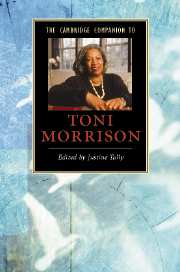Book contents
- Frontmatter
- Introduction: “All necks are on the line”
- Part I Toni Morrison’s fiction
- 1 The Bluest Eye and Sula: black female experience from childhood to womanhood
- 2 Song of Solomon and Tar Baby: the subversive role of language and the carnivalesque
- 3 Beloved or the shifting shapes of memory
- 4 Jazz and Paradise: pivotal moments in black history
- 5 The Morrison trilogy
- 6 Love and the survival of the black community
- 7 The artistic impulse of Toni Morrison’s shorter works
- Part II Toni Morrison’s criticism and editing
- Part III Essays
- Part IV Further Reading
- Index
2 - Song of Solomon and Tar Baby: the subversive role of language and the carnivalesque
from Part I - Toni Morrison’s fiction
Published online by Cambridge University Press: 28 January 2008
- Frontmatter
- Introduction: “All necks are on the line”
- Part I Toni Morrison’s fiction
- 1 The Bluest Eye and Sula: black female experience from childhood to womanhood
- 2 Song of Solomon and Tar Baby: the subversive role of language and the carnivalesque
- 3 Beloved or the shifting shapes of memory
- 4 Jazz and Paradise: pivotal moments in black history
- 5 The Morrison trilogy
- 6 Love and the survival of the black community
- 7 The artistic impulse of Toni Morrison’s shorter works
- Part II Toni Morrison’s criticism and editing
- Part III Essays
- Part IV Further Reading
- Index
Summary
In Song of Solomon (1977) and Tar Baby (1981) Toni Morrison artfully employs African American vernacular language and folklore to foreground her concern with subversion both in the language itself and in narrative structure. Indeed these two novels effectively exemplify M. M. Bakhtin's theory of the carnivalesque through the enactment of ritual spectacles, comic verbal exchanges, and various examples of “abusive” language. In both Song of Solomon and Tar Baby the carnivalesque is at once “heteroglossic” - simultaneously producing multiple meanings - and “disruptive” - challenging hegemonic structures on two levels. First, it establishes an interracial dialogue that challenges white America's view and ordering of the world; and second, it give voice to an intra-racial dialogue, which confronts a privileged black middle-class materialism with the vernacular discourse of the black folk community.
Song of Solomon
For Milkman Dead, Morrison's protagonist in Song of Solomon (SOS), history, identity, and spiritual healing are linked to the power of naming and the verbal facility to impress his experience on the language. This he ultimately achieves through initiation into the discursive formulas of the African American vernacular. Milkman must acquire the vernacular speech and culture of black urban males in order to be spiritually reborn and “discursively” reinserted into a history from which he and his family have been estranged. The narrative structure of Milkman Dead's quest depicts a series of initiatory phases of reappropriation of folk knowledge through encounters with black culture-bearers who actively engage in the production of their own meaning.
- Type
- Chapter
- Information
- The Cambridge Companion to Toni Morrison , pp. 26 - 42Publisher: Cambridge University PressPrint publication year: 2007
- 2
- Cited by

